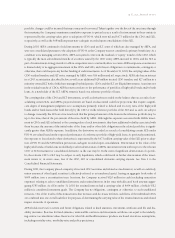American Express 2003 Annual Report Download - page 69
Download and view the complete annual report
Please find page 69 of the 2003 American Express annual report below. You can navigate through the pages in the report by either clicking on the pages listed below, or by using the keyword search tool below to find specific information within the annual report.
(p.67_axp_ financial review)
portfolio, charges could be incurred that may or may not be reversed. Taken together over the lives of the structures through
their maturity, the Company’s maximum cumulative exposure to pretax loss as a result of its investment in these entities is
represented by the carrying values prior to adoption of FIN 46, which were nil and $673 million for the CDO and SLTs,
respectively, as well as the $68 million pretax non-cash gain recorded upon consolidation of the SLTs.
During 2003, AEFA continued to hold investments in CDOs and an SLT, some of which are also managed by AEFA, and
were not consolidated pursuant to the adoption of FIN 46 as the Company was not considered a primary beneficiary. As a
condition to its managing certain CDOs, AEFA is required to invest in the residual or “equity” tranche of the CDO, which
is typically the most subordinated tranche of securities issued by the CDO entity. AEFA invested in CDOs and the SLT as
part of its investment strategy in order to offer a competitive rate to contractholders’ accounts. AEFA’s exposure as an investor
is limited solely to its aggregate investment in the CDOs and SLTs, and it has no obligations or commitments, contingent or
otherwise, that could require any further funding of such investments. As of December 31, 2003, the carrying values of the
CDO residual tranches and SLT notes, managed by AEFA, were $16 million and nil, respectively. AEFA also has an interest
in a CDO securitization described below, as well as an additional $28 million in rated CDO tranches and $27 million in a
minority-owned SLT, both of which are managed by third parties. CDOs and the SLT are illiquid investments. As an investor
in the residual tranche of CDOs, AEFA’s return correlates to the performance of portfolios of high-yield bonds and/or bank
loans. As a noteholder of the SLT, AEFA’s return is based on a reference portfolio of loans.
The carrying value of the CDO and SLT investments, as well as derivatives recorded on the balance sheet as a result of con-
solidating certain SLTs, and AEFA’s projected return are based on discounted cash flow projections that require a signifi-
cant degree of management judgment as to assumptions primarily related to default and recovery rates of the high-yield
bonds and/or bank loans either held directly by the CDO or in the reference portfolio of the SLT and, as such, are subject
to change. Generally, the SLTs are structured such that the principal amount of the loans in the reference portfolio may be
up to five times that of the par amount of the notes held by AEFA. Although the exposure associated with AEFA’s invest-
ment in CDOs and SLTs is limited to the carrying value of such investments, they have additional volatility associated with
them because the amount of the initial value of the loans and/or other debt obligations in the related portfolios is signifi-
cantly greater than AEFA’s exposure. In addition, the derivatives recorded as a result of consolidating certain SLTs under
FIN 46 are valued based on the expected performance of a reference portfolio of high-yield loans. As previously mentioned,
the exposure to loss related to these derivatives is represented by the $673 million carrying value of the SLTs prior to adop-
tion of FIN 46 and the $68 million pretax non-cash gain recorded upon consolidation. Deterioration in the value of the
high-yield bonds or bank loans would likely result in deterioration of AEFA’s investment return with respect to the relevant
CDO or SLT investment or consolidated derivative, as the case may be. In the event of significant deterioration of a portfo-
lio, the relevant CDO or SLT may be subject to early liquidation, which could result in further deterioration of the invest-
ment return or, in severe cases, loss of the CDO, SLT or consolidated derivative carrying amount. See Note 1 to the
Consolidated Financial Statements.
During 2001, the Company placed a majority of its rated CDO securities and related accrued interest, as well as a relatively
minor amount of other liquid securities (collectively referred to as transferred assets), having an aggregate book value of
$905 million, into a securitization trust. In return, the Company received $120 million in cash (excluding transaction
expenses) relating to sales to unaffiliated investors and retained interests in the trust with allocated book amounts aggre-
gating $785 million. As of December 31, 2003, the retained interests had a carrying value of $694 million, of which $512
million is considered investment grade. The Company has no obligations, contingent or otherwise, to such unaffiliated
investors. One of the results of this transaction is that increases and decreases in future cash flows of the individual CDOs
are combined into one overall cash flow for purposes of determining the carrying value of the retained interests and related
impact on results of operations.
AEFA holds reserves for current and future obligations related to fixed annuities, investment certificates and life and dis-
ability insurance. Reserves for fixed annuities, universal life contracts and investment certificates are equal to the underly-
ing contract accumulation values. Reserves for other life and health insurance products are based on various assumptions,
including mortality rates, morbidity rates and policy persistency.
























